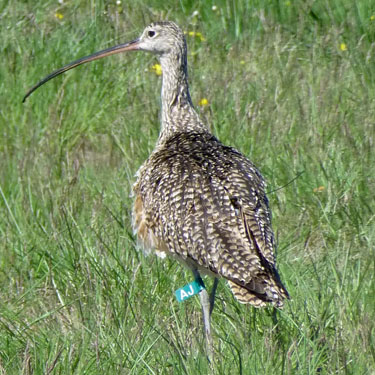One of the most exciting moments experienced by birders is when they spot a banded bird.
In some cases, bird band information can be obtained through the use of spotting scopes or by photographing birds.
There are several types of bird tags and bands used in North America for different purposes.
Standard butt-end bands are the most common type of band used in North America. They are round bands with two edges that butt evenly together when closed correctly.
They are supplied by the Bird Banding Laboratory (BBL) to licensed US banders and by the Canadian Bird Banding Office to licensed Canadian banders free of charge.
Lock-on bands are specifically designed for birds with strong bills like hawks and owls. The lock-on band is used on all medium to large birds of prey other than eagles.
Rivet bands are made of harder metal than the lock-on band and are used on eagles. The band has two short flanges of metal that project out from the seam where the two ends of the band meet.
Neck collars are often used to mark geese or swans. They are large enough that they can be easily read from a distance. Wing markers are used to mark vultures, eagles, swans, ravens, crows, and herons.
A flag is a leg band with tabs that extend away from the leg. The flag color designates the country of banding for shorebirds. Colored leg flags may also have alpha-numeric codes on them that identify the individual bird.
Each type of band is made in many different sizes so that every bird has a suitable size band available for use by banders.
Bands provided by the BBL have the inscription WWW.REPORTBAND.GOV followed by a unique 8 or 9 digit number.
The band number provides valuable data for tracking bird movements, behavior, and survival rates. Bands that have damaged or worn markings can have the numbers determined using an etching process.
If a birder’s photograph captures a migratory bird with a visible band number, it’s usually a good practice to report the sighting to the U.S. Geological Survey.
By reporting the band, participants can contribute to scientific research and, if desired, receive a Certificate of Appreciation for participation.
To report the recovery or sighting of a band, birders should visit the U.S. Geological Survey’s USGS Bird Banding Laboratory website or contact them via email at bandreports@usgs.gov. Bird band reports can also be filed by visiting www.reportband.gov.
Reporting is a simple process that has a significant impact on the understanding and preservation of bird species. Providing information is voluntary but helpful for wildlife management and conservation studies.
The Bird Banding Laboratory provides support and can assist users with the reporting process. Reporting banded birds is a collaborative effort that supports the North American Bird Banding Program and helps protect migratory birds.
Established in 1920, The U.S. Geological Survey (USGS) Bird Banding Laboratory (BBL) is located at the USGS Patuxent Wildlife Research Center (PWRC).
The BBL issues permits and bands to permittees to band birds, records bird band recoveries or encounters primarily through telephone and Internet reporting, and manages more than 72 million banding records and more than 4.5 million records of encounters using state-of-the-art technologies.
The BBL also issues bands and manages banding and encounter data for the Canadian Bird Banding Office (BBO).
Each year approximately 1 million bands are shipped from the BBL to banders in the United States and Canada, and nearly 100,000 encounter reports are entered into the BBL systems.
